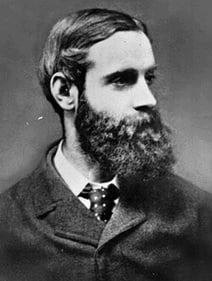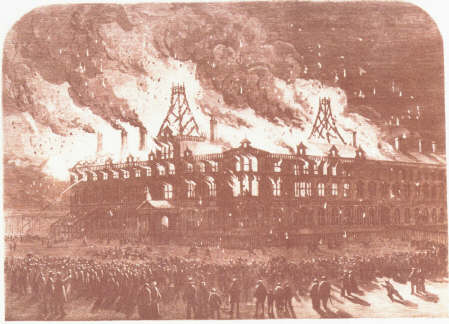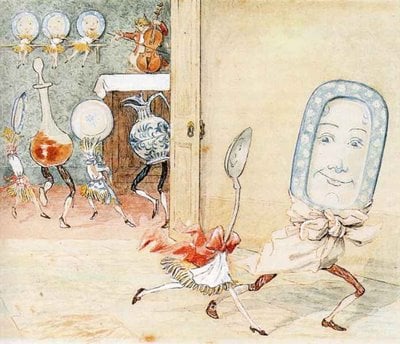Born on March 22, 1846, Randolph Caldecott is best known for his namesake, the Caldecott Medal. Though he's now best known as an illustrator of children's books, Caldecott actually had a wide ranging career. His illustrations depicted foreign travel, high society, and Houses of Parliament. His paintings and sculptures found their way to the Royal Academy.
 Caldecott's Childhood and Education
Caldecott's Childhood and Education
Caldecott passed his early childhood in Chester, where his father was an accountant. He began drawing in his early childhood and gained a reputation as an artist among his fellow students at the parish school. But Caldecott left school at the age of 15 to work at the Whitchurch branch of the Whitchurch and Ellesmere Bank.
Young Caldecott spent his free time sketching and would often stop to draw while he was out visiting clients. Citizens of the town frequently saw him on walkabouts, documenting the local buildings and scenery. It was during these years that Caldecott developed a keen interest in animals and took up hunting.
Building a Career as an Artist
In 1861, Caldecott had his first drawing published: a sketch of a fire that had devastated the Queens Railway Hotel. The piece appeared in the Illustrated London News alongside Caldecott's eyewitness account of the conflagration. When Caldecott moved to the bank's head office at Manchester, he decided to take evening classes at the Manchester School of Art. Soon he'd gotten sketches published both locally and in London. He soon developed a habit of adorning his letters and other documents with illustrative or entertaining sketches; these items have since become highly sought after among Randolph Caldecott collectors.

Caldecott's friend Thomas Armstrong, a painter, introduced Caldecott to London Society editor Henry Blackburn in 1870. Blackburn liked Caldecott's sketches and began publishing them in the magazine. This development made Caldecott confident that he could make a living as an artist. In 1872, he quit his job and moved to London. It took less than two years for Caldecott to successfully establish his new career.
During his seven years in London, Caldcott mostly lived in the heart of Bloomsbury. He came to know the artists and literati of the generation, from Frederic Leighton to Dante Gabriel Rossetti. These connections earned him some interesting commissions, most notably peacock capitals for Leighton's exotic Kensington home. In 1869, Caldecott exhibited a picture at the Royal Manchester Institute, and in 1876, one of his pictures was exhibited in the Royal Academy for the first time. A watercolorist, Caldecott was elected to the Royal Institute of Watercolour Painting in 1872.
Delving into Children's Picture Books
Caldecott already had a brilliant career as an illustrator and cartoonist for multiple weekly and monthly periodicals, but his career took a turn in 1877. That's when Edmund Evans, a renowned color printer, invited Caldecott to illustrate two children's books for Christmas. That year's titles were The Diverting History of John Gilpin (based on William Cowper's eponymous 1872 poem) and The House that Jack Built. The books were so successful that Caldecott produced two more Christmas books every year for the rest of his life. He often wrote the stories and rhymes himself, in addition to illustrating the books.
Meanwhile, Caldecott had also continued illustrating magazines and works by other authors. He did projects for Washington Irving, Juliana Ewing, and Captain Frederick Marryat. Both van Gogh and Gauguin openly admired Caldecott's work. By 1884, Caldecott's Nursery Rhymes books (12 volumes total) had cumulatively sold 867,000 books; Caldecott was an international celebrity.

Unfortunately Caldecott had always suffered from poor health, most notably chronic gastritis. His ailments had prompted many of his travels. In 1886, he and his wife embarked on a tour of the United States, reaching St. Augustine, Florida during an unseasonably cold February. Caldecott took ill and passed away there on February 12, 1886. He has a headstone at a St. Augustine cemetery, along with a memorial designed by Sir Alfred Gilbert in the crypt at St. Paul's Cathedral.
The Caldecott Medal
Randolph Caldecott, often called the "father of children's picture books," was the ideal choice as a namesake for an award honoring exceptional children's illustrators. The award was conceived by the Association for Library Services to Children (ALSC) division of the American Library Association (ALA). It's the most prestigious award for children's picture books in America. Rene Paul Chambellan designed the Medal. It features an adaptation of the cover art from The Diverting History of John Gilpin on one side, and an illustration of "four and twenty blackbirds bak'd in a pie" on the other.

The first Caldecott Medal was awarded to Animals of the Bible, A Picture Book. The book includes an introduction and passages selected from the King James Bible by Helen Dean Fish. It was illustrated by Dorothy P Lanthrop. Since then, the award has consistently honored the most outstanding illustrations in children's books--truly an appropriate legacy for Randolph Caldecott.
See here for a complete list of Caldecott winning titles or get your free Caldecott Guide here:









